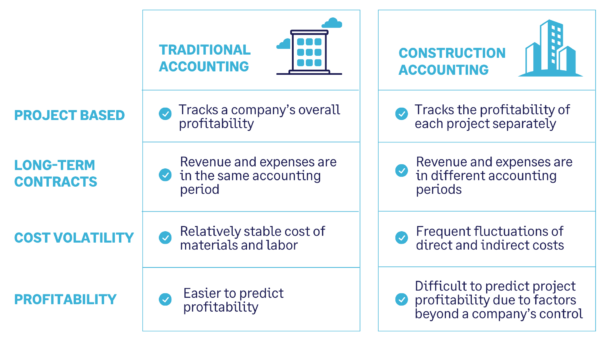Construction Accounting Practices to Boost Your Business’s Profitability
Construction Accounting Practices to Boost Your Business’s Profitability
Blog Article
A Comprehensive Guide to Building Audit: Optimize Your Financial Administration
Effective monetary monitoring is critical in the building market, where the intricacies of project-based revenue and expenses can dramatically impact overall success. A detailed guide to building and construction accounting provides beneficial understandings right into job costing, budgeting, and expense tracking, customized specifically for the distinct difficulties dealt with by experts in this market. By using ideal practices in financial reporting and analysis, stakeholders can not just boost functional performance yet also alleviate possible threats. Understanding these principles is necessary, as they prepared for making notified decisions that can transform financial outcomes. What strategies may be most advantageous for your organization?
Comprehending Construction Audit
Comprehending construction accountancy is important for the successful management of financial resources in the building and construction market. This specialized branch of accounting addresses the one-of-a-kind obstacles dealt with by building and construction firms, consisting of project-based profits recognition, expense monitoring, and compliance with governing requirements. Unlike typical bookkeeping, construction bookkeeping calls for an unique strategy to manage the intricacies related to long-lasting contracts and fluctuating expenses.
Trick elements of building and construction accounting include exact profits recognition, which usually counts on the percentage-of-completion technique or completed-contract technique, relying on the project's nature. This ensures that monetary declarations mirror true performance and earnings with time. Furthermore, job setting you back plays an important function, permitting companies to track expenses connected with particular tasks, which aids in identifying success and source allowance.
One more vital facet is the monitoring of capital, which is typically affected by payment schedules and delays in receivables. Effective cash money circulation monitoring makes certain that building and construction firms can satisfy operational needs and buy future tasks. Inevitably, grasping building bookkeeping equips companies with the devices needed to make enlightened financial decisions, reduce risks, and enhance total operational performance in a competitive industry.

Work Costing and Budgeting
Work setting you back and budgeting are indispensable parts of building and construction audit that make it possible for companies to successfully handle project finances and ensure productivity. Work costing entails the thorough tracking of all costs associated with a details task, including labor, materials, tools, and expenses. This process permits building and construction business to ascertain real cost of completing a work, assisting in informed decision-making and boosting monetary accountability.
Budgeting, on the various other hand, serves as a financial roadmap for jobs. It involves establishing monetary restrictions and designating sources to various project parts, thus developing a framework versus which real expenses can be measured. Efficient budgeting requires detailed analysis and projecting, considering historic data, market trends, and possible risks.
With each other, job setting you back and budgeting provide the necessary tools for construction firms to check monetary efficiency, identify differences, and change approaches as needed - construction accounting. By carrying out robust job setting you back techniques and sticking to well-structured budgets, business can enhance their functional efficiency, alleviate economic risks, and eventually enhance their success in an affordable industry. Thus, these methods are crucial for maintaining lasting success within the building and construction sector
Monitoring Expenditures and Earnings
Properly tracking expenditures and revenue is crucial for construction firms to maintain monetary health and wellness and make certain task practicality. Efficient monitoring enables organizations to check task efficiency, recognize expense overruns, and make notified monetary choices. Carrying out an organized strategy to taping all economic purchases is crucial to achieving this goal.
Utilizing construction accounting software can significantly boost the tracking procedure. These tools help with real-time monitoring of expenses, consisting of labor, products, and subcontractor prices, while additionally catching profits produced from project milestones and customer settlements. By categorizing expenses and earnings streams, firms can acquire understandings right into earnings and capital.

Financial Reporting and Evaluation
Monetary reporting and evaluation play a crucial function in the construction sector, supplying stakeholders with important understandings into a firm's economic performance and functional effectiveness. Accurate monetary records, including equilibrium sheets, earnings statements, and money flow declarations, are fundamental for examining the health of a building and construction service. These documents assist identify patterns, evaluate job productivity, and help with educated decision-making.
In building accounting, monetary evaluation exceeds simple coverage; it involves inspecting monetary data to uncover underlying patterns and anomalies. Secret performance indications (KPIs), such as gross revenue margins, task completion prices, and roi, act as criteria to determine operational success. Consistently examining these metrics permits firms to determine locations calling for renovation, optimize resource allowance, and improve job management methods.
In addition, effective financial reporting fosters this post transparency and builds trust with stakeholders, consisting of customers, distributors, and capitalists - construction accounting. By keeping strenuous financial oversight, building business can alleviate threats, make certain conformity with governing needs, and inevitably drive lasting development. view Hence, a durable economic coverage and analysis structure is crucial for browsing the complexities of the building landscape and accomplishing long-term success
Best Practices for Success
To achieve success in building accounting, companies need to take on a collection of best methods that streamline operations and boost economic administration. First, executing a robust task monitoring software program customized for building can help with real-time tracking of task expenses and budgets, enabling more accurate projecting and resource allocation.
2nd, taking on a constant method to work costing is crucial. This includes diligently tracking all expenses related to each task, including labor, products, and overheads. On a regular basis evaluating task prices against preliminary estimates aids identify variations early, making it possible for timely restorative activities.
Third, keeping rigorous paperwork techniques ensures compliance with policies and streamlines audits. This consists of maintaining thorough documents of YOURURL.com contracts, change orders, invoices, and receipts.
Furthermore, buying team training is essential. Ensuring that staff members are skilled in accounting concepts, software use, and sector standards can considerably improve performance and accuracy in economic coverage.
Verdict

Report this page